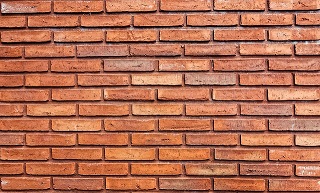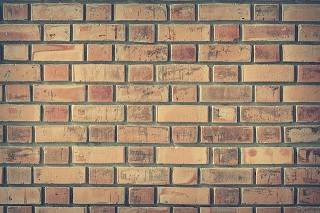Table of Contents
What is Brick Bonds?
Brick Bonds – Bonding is the process of arranging brick with mortar to tie them together. The vertical joints provided in the brick masonry should not continue without proper bonding in between bricks, it is not possible to construct the wall.
Today in this article we are going to know about types of brick bonds and the difference between English bonds and Flemish bonds.
Types of Brick Bonds
- Stretcher Bond
- Header Bond
- English Bond
- Flemish Bond
Stretcher Bond
In this type of bond, all the bricks are arranged in the stretcher course, so the wall having stretchers are in the face.
The elevation of the wall with the stretcher bond is shown in the picture below. this type of bond is useful for one-brick partition walls as there are no headers in such walls.
As this bond does not develop a proper internal bond, it should not be used for walls having a thickness of more than one brick wall. Sometimes, it is also called the running bond.

Also, read – What is pointing? Types of Pointing, Purpose and Method.
Header Bond
In this type of bond, all the bricks are arranged in the header course, So the wall has headers in the facing. The picture below shows the elevation of the wall with a header course.

This bond is used for facing curved surfaces of brickwork. This bond does not have the strength to transmit pressure in the direction of the length of the wall. Thus it is not suitable for the load-bearing wall.
English Bond
In this type of bond, there is an alternative course of the stretcher and header. A queen closer is placed just after the header provides a good overlap. The queen closer is not required in the stretcher course.

The English bond is considered the strongest bond in brickwork and it is generally used in practice. The main features of the English bond are as follows.
- The alternative course in English bond shows headers and stretchers.
- The queen closer is put just next to the queen header to develop the face lap.
- The stretcher course does not require any closer. The queen closer will be compulsory only in header course.
- Stretcher supports each alternate header centrally placed over it.
- The bricks do not break the joints with each other in the same course. The joints are straight.
- It is necessary to place a queen closer after the first header in each header course for breaking the vertical joints in the consecutive course.
- All the headers of a header course are centrally placed over stretchers of the stretcher course.
- If the wall thickness is even multiple of half-brick, a particular course will show either header or stretcher on both the face of the wall.
- For wall having a thickness of two bricks or more, the interior filling is entirely done with the headers.
- Nearly double the number of joints of header course than that in stretcher course.
- As queen closer is liable to get displaced in this position, a header course should never start with a queen closer.
Also, Read – 9 – Types of Tests on Bricks
Flemish Bond
In this type of bond, the headers are distributed evenly and hence, it creates a better appearance than the English bond. Following are the features of the Flemish bond:

- In every course, the headers and stretchers are placed alternatively.
- The queen closer is placed next to the queen header in alternative course to develop the face lap.
- Every header is centrally supported over a stretcher below it.
- For breaking vertical joints in successive courses queen closers are inserted in alternate courses next to the queen header.
- In-wall having their thickness equal to the odd numbers of half bricks the bats are necessary to be used.
- It gives a better appearance than the English bond.
The Flemish bond may be subdivided into two types namely the Single Flemish bond and the Double Flemish bond.
Also, Read – Parapet Wall – Purpose, Types & Uses
Single Flemish Bond – This bond consist of both the English bond and the Flemish bond. This bond is used when expensive bricks are used for face work. The facing of the wall is built with a Flemish bond but filling and backing are built in an English bond.

The purpose of this bond is to combine the strength of the English bond with the appearance of the Flemish bond.
Double Flemish Bond – In double Flemish bond the headers and stretchers are placed alternatively in front as well as the back elevation.

In this bond, the half bats and their quarter bats have required quite amply in-wall having thickness equal to an odd number of bricks.
This bond enables the brick wall to have flush and uniform faces on both sides. This bond is not so strong as the English bond as it contains more stretchers.
Also, Read – AAC Blocks – Properties, Advantages, Disadvantages & Laying Process.
Difference Between English Bond and Flemish Bond

| S.No. | English Bond | Flemish Bond |
| 1 | Header and stretcher are laid in alternative courses. | Header and stretchers are laid alternatively in each course. |
| 2 | Strongest in all types of bonds. | Comparatively less strong for walls more than 1.5 brick. |
| 3 | It gives a rough appearance. | It provides a pleasant appearance. |
| 4 | Absence of vertical joints in the structure. | Partly continuous vertical joints appear in the structure. |
| 5 | Special attention is not required. | Special attention is required. |
| 6 | Progress of work is more. | Progress of work is less. |
| 7 | Costly as no brickbats are used. | Economical as brickbats are used. |
| 8 | It requires less mortar. | It requires more mortar. |
| 9 | This does not require skilled labour. | Skilled labour is required. |
I hope now you understood brick bonds and their type and also the difference between English bonds and Flemish bonds.
If you found this article informative, please be sure to share it.
If you want to give any suggestions, let me know in the comment section.
Thanks!
Also, read
Standard Brick Size – Importance, Types and Tolerance
How to Calculate Quantity of Material For Plastering?
Difference Between Plastering and Pointing
Difference Between Cement Plaster and Gypsum Plaster
Difference Between Plinth Level, Sill Level and Lintel Level.
Unit Weight of Building Materials Used in Construction.